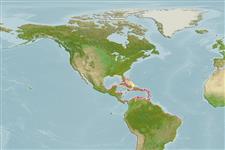Common names from other countries
Environment: milieu / climate zone / depth range / distribution range
Οικολογία
; εύρος βάθους 0 - 1 m (Ref. 83435). Tropical
Western Atlantic: Caribbean to Brazil.
Length at first maturity / Μέγεθος / Βάρος / Age
Maturity: Lm ? range ? - ? cm Max length : 1.8 cm DL αρσενικό/απροσδιόριστο; (Ref. 83435); common length : 2.5 cm TL αρσενικό/απροσδιόριστο; (Ref. 344); μεγ. αναφερόμενη ηλικία: 2.00 έτη (Ref. 8702)
Shell wedge-shaped, inflated. Posterior slope with 2 curved ridges. Surface sculpture consisting of fine radial grooves of microscopic pinpoints. Colour: variable, usually brown, yellowish or purple, with rays of darker hues (Ref. 344).
Assumed total length is 2.5 cm (Ref. 344). Maximum depth from Ref. 104365. Found on beach and shoreline (Ref. 104365). Infaunal in shallow sand, usually in environments rich in particulate organic matter (Ref. 344).
Life cycle and mating behavior
Γεννητική Ωρίμανση | Αναπαραγωγή | Γεννοβολία | Αβγά | Γονιμότητα | Προνύμφες
Members of the class Bivalvia are mostly gonochoric, some are protandric hermaphrodites. Life cycle: Embryos develop into free-swimming trocophore larvae, succeeded by the bivalve veliger, resembling a miniature clam.
Leal, J.H. 2003. (Ref. 344)
IUCN Red List Status (Ref. 130435)
CITES status (Ref. 108899)
Not Evaluated
Not Evaluated
Human uses
| FishSource |
Εργαλεία
Διαδικτυακές πηγές
Estimates based on models
Preferred temperature
(Ref.
115969): 27 - 28.3, mean 27.5 (based on 307 cells).
Ελαστικότητα
Υψηλό, ελάχιστος χρόνος για διπλασιασμό πληθυσμού < 15 μήνες (K=0.43-1.79; tmax=2).
